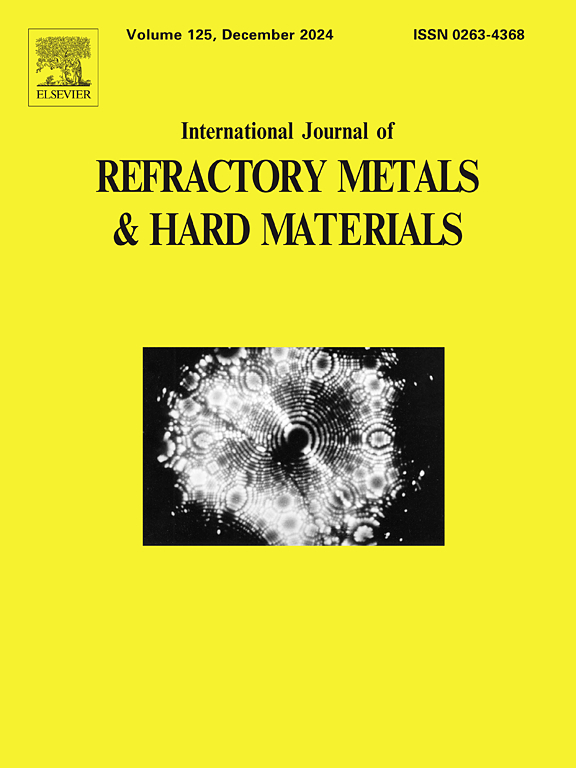Densification and property improvement of Mo-Cu immiscible alloys processed by repressing and re-sintering
IF 4.2
2区 材料科学
Q2 MATERIALS SCIENCE, MULTIDISCIPLINARY
International Journal of Refractory Metals & Hard Materials
Pub Date : 2025-03-02
DOI:10.1016/j.ijrmhm.2025.107131
引用次数: 0
Abstract
Mo-Cu immiscible alloys, due to their good electrical and thermal conductivities as well as excellent mechanical properties, exhibit great application potential as electrical-contact and thermal-management materials in power transportation, domestic appliance and electronic information fields. However, the immiscibility and low wetting ability of Mo and Cu tend to cause that the low relative density and poor physical-mechanical properties of Mo-Cu alloys prepared by conventional powder metallurgy technologies. In this work, repressing and re-sintering technologies together with powder pretreatment are employed to densify Mo-25Cu (wt%) immiscible alloys processed by a liquid sintering with H2 protection and thus improve their physical-mechanical properties. The results indicate that microstructures of all alloys mainly consist of Mo phase domains surrounded by mesh Cu phases. With repressing and re-sintering proceeding, relative densities and physical-mechanical properties of the alloys processed by whether the mixed powder or the milled powder both gradually increase. This mainly results from two aspects of reasons: i) the capillary filling effect of Cu melt during the sintering and ii) the collective motion of two phases dominated by the plastic deformation of meshy Cu phase during the isostatic loading. More importantly, it is found that all properties of the consolidated alloys using the milled powder are better, which could be attributed to the relatively even microstructure because of the more homogeneous phase distribution in the milled powder. This study can promote the advance of investigations on processing, microstructure and properties of high-performance immiscible alloys manufactured by net shape forming.
抑制和再烧结钼铜不混相合金的致密化及性能改善
钼铜非混相合金由于具有良好的导电性和导热性以及优异的力学性能,在电力运输、家用电器和电子信息等领域作为电接触材料和热管理材料具有很大的应用潜力。然而,Mo和Cu的不混溶性和较低的润湿性往往导致传统粉末冶金技术制备的Mo-Cu合金相对密度低,物理力学性能差。采用抑制和重烧结技术,结合粉末预处理技术,在H2保护下对Mo-25Cu (wt%)非混相合金进行液相烧结,使其致密化,从而提高其物理力学性能。结果表明:所有合金的显微组织主要由Mo相域和网状Cu相包围组成。无论是混合粉还是磨粉,经过压制和再烧结处理后,合金的相对密度和物理力学性能都逐渐提高。这主要有两个方面的原因:1)烧结过程中Cu熔体的毛细填充效应;2)等静力加载过程中以网状Cu相塑性变形为主的两相集体运动。更重要的是,经磨粉处理的固结合金的各项性能都较好,这可能是由于磨粉中相分布更为均匀,使得固结合金的组织相对均匀。该研究可促进网状成形制备高性能非混相合金的工艺、组织和性能研究的进展。
本文章由计算机程序翻译,如有差异,请以英文原文为准。
求助全文
约1分钟内获得全文
求助全文
来源期刊
CiteScore
7.00
自引率
13.90%
发文量
236
审稿时长
35 days
期刊介绍:
The International Journal of Refractory Metals and Hard Materials (IJRMHM) publishes original research articles concerned with all aspects of refractory metals and hard materials. Refractory metals are defined as metals with melting points higher than 1800 °C. These are tungsten, molybdenum, chromium, tantalum, niobium, hafnium, and rhenium, as well as many compounds and alloys based thereupon. Hard materials that are included in the scope of this journal are defined as materials with hardness values higher than 1000 kg/mm2, primarily intended for applications as manufacturing tools or wear resistant components in mechanical systems. Thus they encompass carbides, nitrides and borides of metals, and related compounds. A special focus of this journal is put on the family of hardmetals, which is also known as cemented tungsten carbide, and cermets which are based on titanium carbide and carbonitrides with or without a metal binder. Ceramics and superhard materials including diamond and cubic boron nitride may also be accepted provided the subject material is presented as hard materials as defined above.

 求助内容:
求助内容: 应助结果提醒方式:
应助结果提醒方式:


